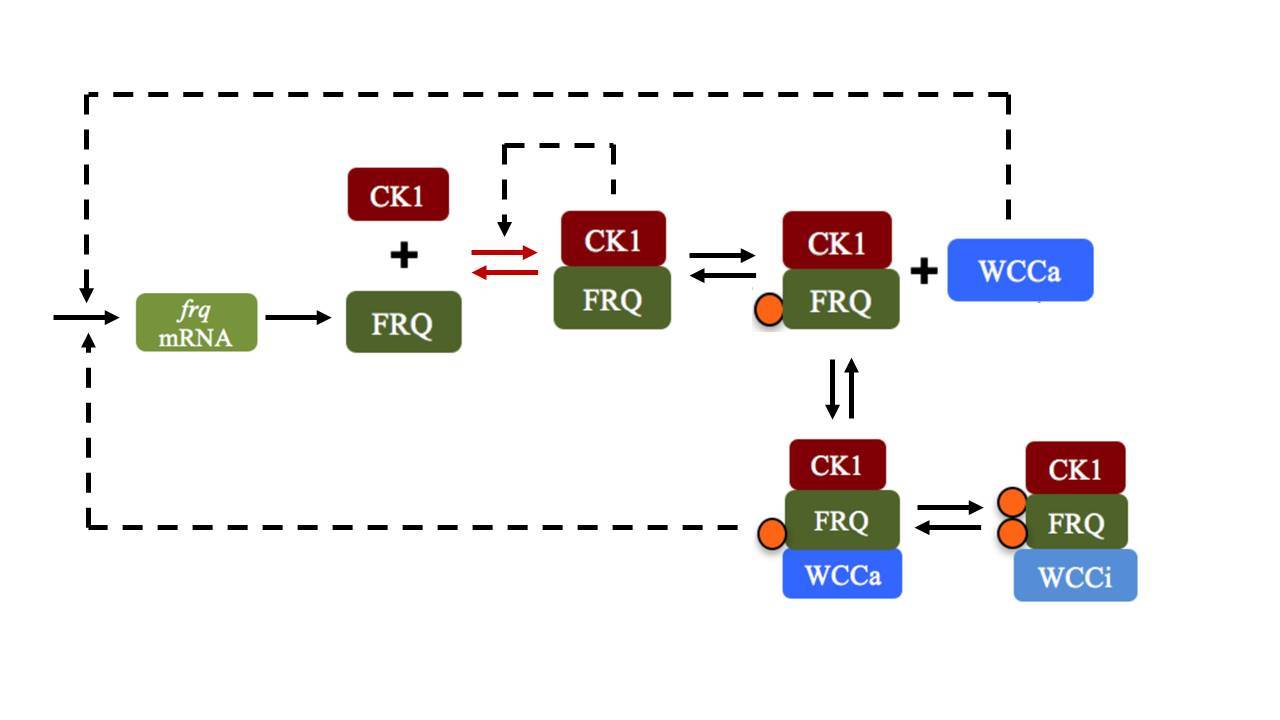Circadian clock is an important time keeping system that controls temporal expression of numerous genes regulating rhythmic cellular and physiological functions as we go through our daily routines (e.g. sleep/wake, meals, exercise, etc.). In the past four decades, scientists have extensively investigated molecular components and detailed mechanisms generating an autonomous oscillations of about 24 hours, which consists of a time-delayed transcriptional/translational feedback loop. Despite our extensive knowledge of circadian clock mechanisms, the main rate-limiting step that determines circadian period length remains unclear. To address this fundamental question, we used the model filamentous fungus, Neurospora crassa, to investigate key processes that determine the speed of circadian rhythms.
Previously, protein stability of clock proteins was thought to be the main determinant of circadian period length in eukaryotic clocks (Liu et al., 2000 PNAS; Ruoff et al, 2005). However, Drs. Jay Dunlap and Luis Larrondo’s labs recently demonstrated that the stability of a core clock protein can be uncoupled from the circadian period length in Neurospora, suggesting that clock protein stability is not a major determinant of clock period (Larrondo et al, 2015). Then, what could be the main rate-limiting step determining the period of circadian rhythms? Phosphorylation of a core clock protein has been shown to affect circadian period length, and formation of a stable complex between clock proteins and its kinase CK1 is a conserved feature in eukaryotic circadian mechanisms. Therefore, we systematically examined the interaction between FRQ and CK1 in different clock mutants including specific mutations that perturb FRQ-CK1 interactions, and discovered a strong negative correlation between this interaction and period length in clock mutants. Remarkably, the mutants with altered FRQ-CK1 interaction showed dramatic lengthening of circadian period of up to 48 hours, which are the most severe circadian period mutants ever reported. Furthermore, the impact of FRQ-CK1 interaction on circadian period can be explained by its dual roles on affecting FRQ phosphorylation and FRQ activity. To obtain a deeper insight of the clock mechanism, we constructed a mathematical model for systematic analysis of specific parameters/steps that determine the pace of circadian rhythms. Our computer simulations further confirmed that the FRQ-CK1 interaction is the main rate-limiting step that determines the period of circadian rhythms in Neurospora. Because of the conservation of eukaryotic circadian clocks, a similar mechanism may also act in animal circadian clocks.
Please read our paper published in Nature Communications ( https://www.nature.com/articles/s41467-019-12239-w ) and let us know your comments.
Liu, Y., Loros, J. & Dunlap, J.C. Phosphorylation of the Neurospora clock protein FREQUENCY determines its degradation rate and strongly influences the period length of the circadian clock. Proc. Natl. Acad. Sci. USA 97, 234-239 (2000).
Ruoff, P., Loros, J.J. & Dunlap, J.C. The relationship between FRQ protein stability and temperature compensation in the Neurospora circadian clock. Proc. Natl. Acad. Sci. USA. 102, 17681-17686 (2005).
Larrondo, L.F., Olivares-Yanez, C., Baker, C.L., Loros, J.J. & Dunlap, J.C. Circadian rhythms. Decoupling circadian clock protein turnover from circadian period determination. Science 347, 1257277 (2015).








Please sign in or register for FREE
If you are a registered user on Research Communities by Springer Nature, please sign in